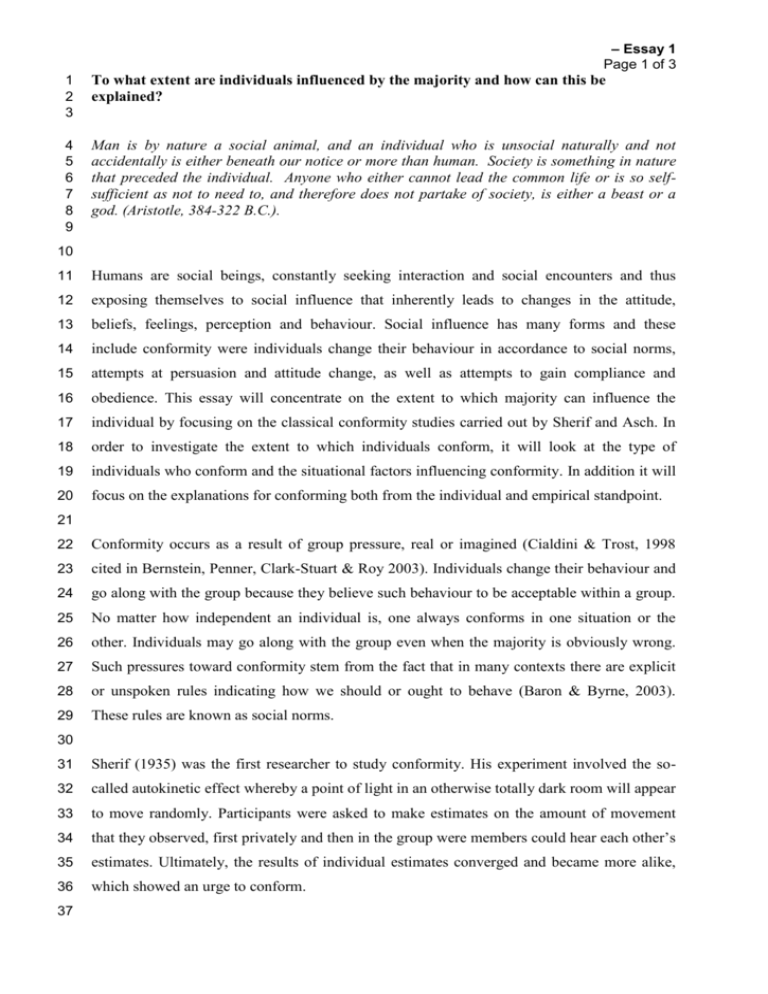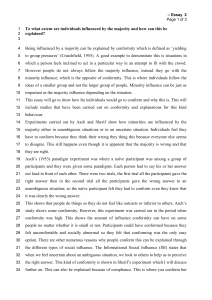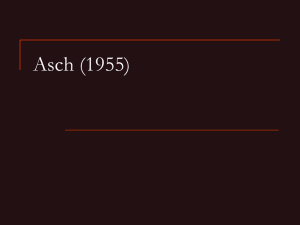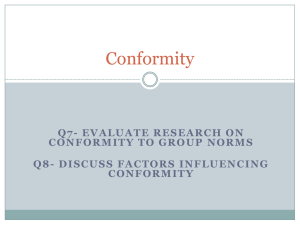Specimen essay on social influence 1
advertisement

– Essay 1 Page 1 of 3 1 2 3 To what extent are individuals influenced by the majority and how can this be explained? 4 5 6 7 8 9 Man is by nature a social animal, and an individual who is unsocial naturally and not accidentally is either beneath our notice or more than human. Society is something in nature that preceded the individual. Anyone who either cannot lead the common life or is so selfsufficient as not to need to, and therefore does not partake of society, is either a beast or a god. (Aristotle, 384-322 B.C.). 10 11 Humans are social beings, constantly seeking interaction and social encounters and thus 12 exposing themselves to social influence that inherently leads to changes in the attitude, 13 beliefs, feelings, perception and behaviour. Social influence has many forms and these 14 include conformity were individuals change their behaviour in accordance to social norms, 15 attempts at persuasion and attitude change, as well as attempts to gain compliance and 16 obedience. This essay will concentrate on the extent to which majority can influence the 17 individual by focusing on the classical conformity studies carried out by Sherif and Asch. In 18 order to investigate the extent to which individuals conform, it will look at the type of 19 individuals who conform and the situational factors influencing conformity. In addition it will 20 focus on the explanations for conforming both from the individual and empirical standpoint. 21 22 Conformity occurs as a result of group pressure, real or imagined (Cialdini & Trost, 1998 23 cited in Bernstein, Penner, Clark-Stuart & Roy 2003). Individuals change their behaviour and 24 go along with the group because they believe such behaviour to be acceptable within a group. 25 No matter how independent an individual is, one always conforms in one situation or the 26 other. Individuals may go along with the group even when the majority is obviously wrong. 27 Such pressures toward conformity stem from the fact that in many contexts there are explicit 28 or unspoken rules indicating how we should or ought to behave (Baron & Byrne, 2003). 29 These rules are known as social norms. 30 31 Sherif (1935) was the first researcher to study conformity. His experiment involved the so- 32 called autokinetic effect whereby a point of light in an otherwise totally dark room will appear 33 to move randomly. Participants were asked to make estimates on the amount of movement 34 that they observed, first privately and then in the group were members could hear each other’s 35 estimates. Ultimately, the results of individual estimates converged and became more alike, 36 which showed an urge to conform. 37 – Essay 1 Page 2 of 3 38 The first systematic study on conformity was that carried out by Solomon Asch (1951), whose 39 research became a classic in social psychology. Asch disagreed that Sherifs experiment 40 demonstrated conformity. According to Asch, the fact that Sherif’s task was ambiguous, in 41 that there was no right or wrong answer, made it difficult to draw conclusions about 42 conformity in group situations (Gross & McIlveen 1998). In Asch’s view, the best way to 43 measure conformity was in terms of a person’s tendency to agree with other people who 44 unanimously give the wrong answer on a task with an obvious and unambiguous solution 45 (Gross & McIlven 1998). In one of Ashc’s experiments, participants were shown a display of 46 vertical lines of different lengths and were asked to indicate which of three comparison lines 47 matched a standard line in length, whereby he included his assistants as participants, who 48 were unknown to real participants. On several occasions Ashc’s assistants were asked to give 49 answers that were obviously incorrect which they stated before the real participants 50 responded. Most participants went along with the wrong answer; they chose conformity over 51 their own judgement. On several different studies the average of those tested, conformed to 52 the group response on 32% of the trials and 74% conformed at least once. 53 54 Although most participants conformed there were some individual differences, -some 55 participants conformed more frequently than others. More recent research has shown that 56 people who tend to conform have low self-esteem (Johnson, 1995), score high on anxiety 57 measures (Bem, 1994), and have low IQ scores (Weschler et al, 2001). Thus, empirical 58 research support that people have certain traits which predispose them to go along with the 59 group. It has also been shown that women are more likely than men to conform (Deaux, 60 1991). Deaux argued that this may be because the women in his study possessed the traits 61 outlined above. The rationale for conforming has also been explored by investigating what 62 people themselves have said. After the experiment Asch asked the participants who 63 conformed to outline why they conformed and they explained this in several ways; they felt 64 influenced by the pressure from the rest of the group, and did not want to appear foolish, 65 some wondered if their eyesight was reliable and some denied being aware they had given 66 incorrect answers. Thus, it appears that people who conform doubt their own ability and fully 67 trust the ability of their peers or group members. 68 69 However, trusting the ability of ones peers and doubting ones own ability to judge does not 70 necessarily mean that people who conform have changed their private view on a matter. This 71 was shown by Asch in a later experiment. He found that when the participants were asked to 72 write their response on a piece of paper instead of saying them out loud, conformity dropped – Essay 1 Page 3 of 3 73 distinctively as they would not be exposed giving a different answer in the group. Other 74 research has showed the same tendency e.g. (Mass & Clark, 1984 cited in Baron &Byrne 75 2003) also showed that individuals were likely to follow social norms overtly without actually 76 change their private views. 77 78 Asch’s research proved that conformity occurs as a result of group pressure and that people 79 who were insecure about their own ability were more susceptible to this pressure, but he also 80 showed that conformity does not occur to the same degree in all settings. The extent to which 81 the group or majority can influence an individual is determined by many situational factors. 82 One of these factors is cohesiveness which means we are influenced by those we like. 83 Cohesiveness can be defined as the degree of attraction felt by individuals toward some group 84 (Baron & Byrne 2003). The new hairstyle taken in by those who are popular is more likely to 85 spread than if this new hairstyle was adopted by those who are viewed as unpopular and 86 weird. Research findings indicate that cohesiveness exerts strong effects on conformity 87 (Crandall, 1988; Latane & L’Herrou, 1996 cited in Baron & Byrne 2003). The other factor 88 affecting conformity is the group size. Asch found that conformity increases with the larger 89 group but only up to three people. No further increase in conformity was evident once the 90 majority size went beyond three. More recent studies (Bond & Smith, 1996 in Baron & 91 Byrne, 2003) have suggested that increased majority sizes beyond three will increase 92 conformity, but by smaller and smaller number. 93 94 Conformity is a fascinating issue which has intrigued both lay people and social psychologist 95 over the years. Pioneering research by Asch and Sherif has provided insight into its 96 mechanics e.g. research in the field have shown that the degree of conformity is influenced by 97 situational factors such as group size and cohesiveness. Moreover, it appears that individuals 98 with certain traits are more likely to conform than others. Despite the complexity of the issue, 99 empirical research support that most individuals conform to the imagined or real group norms, 100 which is chilling news for a society that parades individuality and freedom of choice. 101 102 REFERENCES: 103 Baron, R. A.& Byrne, D. (2003). Social Psycholoy. Boston : Allyn & Bacon. 104 Gross, R. & McIlven, R. (1998). Psychology: A New Introduction. Oxon: Bookpoint, Ltd. 105 Gleitman, H. (1995). Psychology. New York: Norton.








